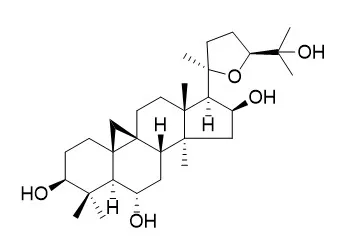| In vitro: |
| Biochem Biophys Res Commun. 2014 Jul 18;450(1):306-11. | | Cycloastragenol, a triterpene aglycone derived from Radix astragali, suppresses the accumulation of cytoplasmic lipid droplet in 3T3-L1 adipocytes.[Pubmed: 24942874 ] | Cycloastragenol (CAG), a bioactive triterpenoid sapogenin isolated from the Chinese herbal medicine Radix astragali, was reported to promote the phosphorylation of extracellular signal-regulated protein kinase (ERK).
METHODS AND RESULTS:
Here we investigated the effect of CAG on adipogenesis. The image-based Nile red staining analyses revealed that CAG dose dependently reduced cytoplasmic lipid droplet in 3T3-L1 adipocytes with the IC50 value of 13.0 μM. Meanwhile, cytotoxicity assay provided evidence that CAG was free of injury on HepG2 cells up to 60 μM. In addition, using calcium mobilization assay, we observed that CAG stimulated calcium influx in 3T3-L1 preadipocytes with a dose dependent trend, the EC50 value was determined as 21.9 μM. There were proofs that elevated intracellular calcium played a vital role in suppressing adipocyte differentiation.
CONCLUSIONS:
The current findings demonstrated that CAG was a potential therapeutic candidate for alleviating obesity and hyperlipidemia. | | Neurosignals. 2014;22(1):52-63. | | Cycloastragenol is a potent telomerase activator in neuronal cells: implications for depression management.[Pubmed: 25095809] | Cycloastragenol (CAG) is an aglycone of astragaloside IV. It was first identified when screening Astragalus membranaceus extracts for active ingredients with antiaging properties.
METHODS AND RESULTS:
The present study demonstrates that Cycloastragenol stimulates telomerase activity and cell proliferation in human neonatal keratinocytes. In particular, Cycloastragenol promotes scratch wound closure of human neonatal keratinocyte monolayers in vitro. The distinct telomerase-activating property of Cycloastragenol prompted evaluation of its potential application in the treatment of neurological disorders. Accordingly, Cycloastragenol induced telomerase activity and cAMP response element binding (CREB) activation in PC12 cells and primary neurons. Blockade of CREB expression in neuronal cells by RNA interference reduced basal telomerase activity, and Cycloastragenol was no longer efficacious in increasing telomerase activity. Cycloastragenol treatment not only induced the expression of bcl2, a CREB-regulated gene, but also the expression of telomerase reverse transcriptase in primary cortical neurons. Interestingly, oral administration of Cycloastragenol for 7 days attenuated depression-like behavior in experimental mice.
CONCLUSIONS:
In conclusion, Cycloastragenol stimulates telomerase activity in human neonatal keratinocytes and rat neuronal cells, and induces CREB activation followed by tert and bcl2 expression. Furthermore, Cycloastragenol may have a novel therapeutic role in depression. | | Planta Med., 2011, 77(12):1444. | | Protective Effects of Astragaloside IV and Cycloastragenol in 6-hydroxydopamin (6-OHDA)-Induced Neurotoxicity in PC12 Cells[Reference: WebLink] | Cycloastragenol (CG), which is a minor metabolite mostly found in its glycosidic form, was obtained from AST-IV via hydrolysis reaction. CG has been shown to extend T cell proliferation by increasing telomarase activity showing that it may also help delay the onset of cellular aging (1). Indeed, recently, CG has been introduced to the market as a new generation antiaging molecule. Moreover our studies proved CG as an extraordinary wound healing agent (2). Although AST-IV's neuroprotective effects on Parkinson's disease was reported previously, there has been no data for CG.
METHODS AND RESULTS:
The aim of this study was to investigate the protective effects of AST-IV and CG on neurotoxicity induced by 6-hydroxydopamin (6-OHDA) in PC12 cells, an excepted in vitro model for Parkinson's disease. The cells were seeded on tissue culture plates for 24h. After 24 hours, they were incubated with AST-IV (0.1μM-1 fM) and CG (0.1μM-1 fM) for 30min before the insults with 200μM 6-OHDA. The cells were incubated for 24h. Cell viability and cells death were assessed by (3-(4,5-dimethylthiazol-2yl)-2,5-diphenyltetrazolium bromide) MTT assay and lactate dehydrogenase (LDH) assay kit, respectively. AST-IV and CG inhibited the apoptosis of PC12 induced by 6-OHDA at 0.001 and 0.0001μM concentrations.
CONCLUSIONS:
On the basis of these results, we propose AST-IV and CG as potential neuroprotective agents in the treatment of Parkinson's disease. |
|






 Cell. 2018 Jan 11;172(1-2):249-261.e12. doi: 10.1016/j.cell.2017.12.019.IF=36.216(2019)
Cell. 2018 Jan 11;172(1-2):249-261.e12. doi: 10.1016/j.cell.2017.12.019.IF=36.216(2019) Cell Metab. 2020 Mar 3;31(3):534-548.e5. doi: 10.1016/j.cmet.2020.01.002.IF=22.415(2019)
Cell Metab. 2020 Mar 3;31(3):534-548.e5. doi: 10.1016/j.cmet.2020.01.002.IF=22.415(2019) Mol Cell. 2017 Nov 16;68(4):673-685.e6. doi: 10.1016/j.molcel.2017.10.022.IF=14.548(2019)
Mol Cell. 2017 Nov 16;68(4):673-685.e6. doi: 10.1016/j.molcel.2017.10.022.IF=14.548(2019)